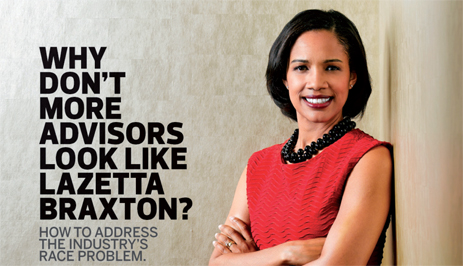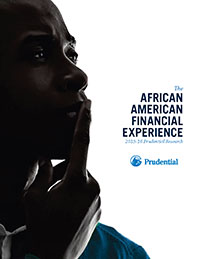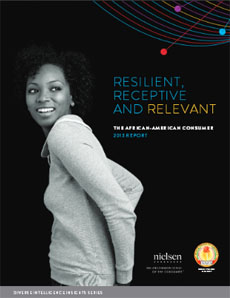Teaching African Americans to Budget, Save and Plan for the Future

NBCI Search
NBCI Featured Program

Why Don't More Financial Advisors Look Like Lazetta Braxton"? - How to Address the Industry's Race Problem More black families are entering the economic mainstream, have more income and are saving for college and retirement.... They need advice and [the financial services industry] is passing up millions of dollars by not reaching out to them. -Rev. Anthony Evans

How to Find
a Job in a Recession
See tips from the experts.
Job Search
Roundup
Tips for a successful
job search
NBCI Feature Article
 Affordable Term Life Insurance - Help Create Financial Security for Your Family
Affordable Term Life Insurance - Help Create Financial Security for Your Family
 We can't tell you enough how critical Life insurance is to financial planning.
We can't tell you enough how critical Life insurance is to financial planning. It's a necessity for anyone with dependents who would be affected financially by your demise. Together with The Dream Company, NBCI is offering affordable Term Life Insurance. You can own a policy, for as low as $2 a week*, that will protect your family. APPLY NOW >>
INSIDE THIS SECTION
- Overview
- Life Insurance
- Automobile Insurance
- Homeowner’s and Renter's Insurance
- Disability Insurance
- Long-term Care Insurance
- Special Policies
THE PURPOSE OF LIFE INSURANCE
 Do you need life insurance?
Do you need life insurance?Ask yourself these simple questions.
- Do you have a child or loved one that depends on you for financial support?
- Do you have enough money saved or invested to adequately provide for your family in the event of your premature death?
If you answered “yes” to any of these questions, then let us help you build financial security with Term Life Insurance. You can own a policy that will protect your family, for as little as $2 a week*. Click Here to Get started >
In today's world, life insurance policies serve many purposes including the protection of families against premature death of the primary income earner. Proceeds from a life insurance policy can offer a measure of survivor protection by paying for final expenses such as funeral/burial costs, medical bills, taxes and unpaid loans.
Another purpose of life insurance is to create an immediate estate upon the insured's death. In simple terms, an estate is the net worth of a person at any given time. It is the sum total of a person's assets including all cash, property or possessions, minus all liabilities. When the insured dies, his or her life insurance benefits will add an immediate amount of cash to the beneficiary's estate; hence the term Immediate Estate. With proper planning, the primary income earner can create, protect and preserve his or her estate for the family upon the insured's premature death.
Another important feature about life insurance is that, by law, life policies typically bypass the sometimes complicated and technical world of probate by paying the death proceeds directly to the insured's named beneficiary. This feature allows the beneficiary to receive the proceeds in a timely manner and avoid the expense of probate.
Whatever your reasons for purchasing a life or health insurance policy, it is essential that you protect your greatest resource – your ability to provide an income for your family. Unexpected death, sickness or disability could put an end to this income potential and these perils could leave a lasting effect on those who depend on your ability to provide an income.
TYPES OF LIFE INSURANCE
TERM LIFE INSURANCE - APPLY NOW >
Term Life is more affordable than permanent insurance and is also the most popular. Insuring the Dream offers flexible Term Life Coverage that includes several benefits:
- No Medical Exam Required – One Health Question
- Child(ren) Rider
- Accelerated Benefits – Receive a portion of coverage payment in the event of a Chronic Illness
- Affordable Group Rates – 5 Year Age Bans rate adjustments
- Accidental Death & Dismemberment Rider Option
- Our Insurance Underwriter's has A++ Best/Standard and Poor's AA+ rating**
OTHER TYPES TERM LIFE INSURANCE POLICIES AVAILABLE
NOTE: All of these require a medical exam prior to approval of coverage.
- Convertible – This version can be converted into permanent coverage at any time without a medical exam.
Premiums may increase if you elect to convert your coverage.
- Level – The cost of this version stays the same every year, as do the benefits. If you want to renew at the
end of coverage, you can expect a significant increase in premium, as you will have aged.
- Decreasing – In exchange for premiums that remain the same during the term, the benefits of this version decreases as more time passes.
PERMANENT LIFE INSURANCE
Permanent insurance is more expensive than term, but has four variations to fit different needs. Contact The Dream Company, LLC for more information and quotes.
- Whole life – You pay a fixed premium your entire life and receive a fixed benefit at death. It includes a cash
savings feature that may, over time, grow to a substantial amount.
- Universal life – This option gives greater flexibility than whole life as you are able to change the amount of
the coverage you get as your needs change.
- Variable life – This option invests some of your premiums in the market to try to increase your benefit. It
usually includes a minimum guaranteed death benefit, but not a minimum cash value.
- Variable-Universal life – This option combines the premium and death benefit flexibility of universal life with the investment flexibility and risk of variable life.
**INSURANCE COMPANY RATING SYSTEM A Standard & Poor's Insurer Financial Strength Rating is a current opinion of the financial security characteristics of an insurance organization with respect to its ability to pay under its insurance policies and contracts in accordance with their terms.
| Rating Agency A.M. Best Standard & Poor's Moody's |
Rating (Category) A++ (Superior) AA+ (Very Strong) Aa2 (Excellent) |
Automobile Insurance
Drive a bargain when you buy the car.
Not when you insure it.
Automobile insurance is probably the most important policy to have because vehicles represent the highest amount of risk the average person will face in his or her life. Having the right protection here is critical, so don't go for the cheapest coverage. Go with what's right for you.
The cost of your policy will be based on:
- Your age. Under 25 is the most expensive group. Aren't you glad you're older?
- Where you live. The more crowded the area you live in, the higher your rates simply because congestion leads to more incidents.
- Number of miles driven per year. The average car sees 12,000 miles a year. If yours gets less, you could save money.
- Type of vehicle. Some vehicles may cost more to cover, even if they cost the same to buy. Sports cars top the list. But SUVs and luxury sedans may cost extra, too.
- Age of vehicle. As cars age, they become worth less. Accordingly, the cost to insure goes down. Unless it's a collector's car.
- Your driving record. Simply put, the better a driver you are, the less you may pay. Have tickets or accidents, though, and prepare to shell out.
- Your credit history. A correlation has been found between financial risk and insurance risk. So keep your bills up to date to avoid paying extra.
- Others on policy. If you're not the only driver, expect your rates to take into account everyone else's experience, record and miles driven, too.
- Liability. Covers property damage or physical injury to others caused by you. Consider more than the minimum to protect yourself in a lawsuit.
- Collision. Pays for repairs to your vehicle. It's required by banks if you have a loan on your car, or lease it. Save money by choosing a larger deductible.
- Comprehensive. Anything other than accidents, or excluded events is covered here: theft, fire, vandalism, flooding and hail, for example.
- Uninsured and Underinsured Motorist. Fills in if the other party in the accident has too little, or no insurance, or leaves the scene.
- Medical or Personal Injury Protection. Covers medical expenses no matter who's at fault. It may also extend to non-medical payments for lost wages, childcare and other important expenses.
- www.edmunds.com - find out insurance requirements by state.
- www.choicetrust.com - get a free report of your accident record.
Homeowner's and Renter's Insurance
Homeowner, Condo, Townhouse or Renter's insurance does more than protect your home and possessions. It also protects you, your family and your way of life. But not all coverage is created equal, so make sure you know what to expect when you go looking for a policy. This is a good place to start.
What's covered?
- Dwelling. This is for damage to your house and outbuildings such as detached garages or sheds. Choose a policy with automatically increasing coverage, or do it yourself as your home's value goes up.
- Personal Property. Covers household items such as furniture, clothing and appliances. If you have anything unusual or valuable, such as art or antiques, get a rider that specially covers those items.
- Liability. Protects you from financial loss if found responsible for someone else's injury or property damage. You can typically get up to $1 million in coverage.
- Medical payments. This covers medical payments for people injured on your property or injuries away from home you're responsible for. Such as your dog biting someone.
- Loss of use. Covers living expenses if your home is not inhabitable during repairs. Typically this coverage provides up to 20% of the total your home is insured for, but you can get higher limits.
- Earthquake. If you live in an earthquake-prone area, or a home on a slab with pipes buried in the foundation, consider adding this.
- Flooding. Water from above is covered in regular policies. Water from below is not. If you live in a potential flood area, look for extra coverage.
- Landscaping. Even though landscaping adds to the beauty of your home, it's not covered for damage by wind or hail.
- Termites. Yes, they can do a number on your home. But no, it's not covered.
Homeowner's Insurance Tips
Inventory valuables before there's a problem. Photos of the items taken in your home can help prove their existence. So be sure to keep the pictures in a safe place that you can access after a theft or fire.
You might be able to get a discount for some or all of the following:
- Impact-resistant roof
- Noncombustible roof
- Personal property marked with identifying number
- Burglar, fire and smoke alarm systems
- Fire extinguishers
- Home security devices
- Senior Citizens discount
- House insured to full replacement cost
Disability Insurance
You want to work. But what if you can't?
If you get sick or hurt and can't work for an extended period of time, disability insurance may be the difference between your family maintaining its lifestyle and making serious changes.
Disability insurance replaces a portion of your regular income when accident or illness keeps you from working. It's usually offered as short-term coverage - which lasts up to 6 months, and long-term coverage - which covers situations lasting six months or more. Often it will be included in benefit packages employers offer, so check at work to see if it's available to you and at what level. Typical policies provide about 60% of your gross (before tax) salary, but you can usually purchase additional coverage for a small increase in cost.
What you should know about disability insurance:
- The definition of disability varies. Make sure any policy you consider covers situations you view as likely, or possible.
- Look for non-canceling policies. You want a policy that cannot be cancelled and guarantees renewals as long as your premiums are up to date - no matter how your health is.
- Some benefits are taxed. Not all. If you pay for disability coverage with a before-tax payroll deduction, the benefits will be taxed. Pay for it after taxes (usually an individual policy) and they won't.
- You may want increasing premiums. If the coverage is too expensive, you might consider a policy that charges less while you're young and more as you age. As earning power generally increases, you should be able to afford the increased expense later on.
- Social Security disability is hard to qualify for. If you intend to rely on Social Security Disability coverage, know that you may have to prove yourself unable to perform any job, not just yours. Even types of work not available in your area.
- Social Security Riders. It can take months to see a check from Social Security if your claim is accepted, so you may want a Rider to bridge the gap.
Want more information?
- Read the non-profit Health Insurance Association of America's (HIAA) Guide to Disability Income Insurance.
- Assess your need for disability insurance at the Life and Health Foundation for Education.
Take Action
- Fill out the checklist on what things to consider when deciding on a disability policy from the Consumer Federation of America.
- For a simple assessment of your need for disability insurance, go to the Life and Health Foundation for Education.
- Read entries or join in discussions at the Disability Insurance Forums message board.
- The Health Insurance Association of America (HIAA), a nonprofit association of insurance companies, has published a "Guide To Disability Income Insurance."
- Look for an insurer in your state for any type of insurance, using an online service from the Insurance Information Institute.
Long-Term Care Insurance
Be sure that the insurance company offering the policy will be financially sound when, or if, it comes time to pay your claim. Use these services:
- Long-term Care Insurance
- Long term Care Coverage
- Good to have if you need help
Long-term care insurance doesn't cover medical care for people with disabilities or long-term illness. It covers the related expenses that health insurance doesn't: In-home help, adult day care, assisted living services, visiting nurses, even care in a nursing home.
So what should you know and look for?
- Long-term care is expensive. You could easily spend your life's savings on long-term care in a short amount of time.
- Medicare doesn't cover long-term care. Medicaid will, but only after you've already spent most of your money, leaving little to live on.
- Don't wait to buy. If you wait until your 70s - or later - you'll likely be deemed high risk. You'll either be denied or charged astronomical premiums. Consider getting it while middle-aged - and premiums are lower.
- Consider the cost. If the premiums will lower your standard of living now, or you'll have difficulty affording them in the future, this coverage may not be for you.
- Coverage. You can select nursing-home care only. Home-care only. Or mixed-care that includes nursing homes, assisted living, adult day care and maybe even care in your home by a friend or family member.
- Benefit amount. The daily or monthly benefit is the maximum the coverage will pay for each day or month you are covered. If your expenses are higher, you'll be responsible for the difference.
- Benefit period. This determines how long your coverage lasts. Choose as little as two years, or as long as the rest of your life.
- Waiting period. The waiting period is like the deductible on your auto insurance. The longer it is, the lower your premium. But the more you'll spend on care, yourself. Waiting periods are usually from 0-100 days.
- Inflation protection. With health care costs rising every year, a policy without inflation protection is unlikely to provide sufficient coverage by the time you actually need it. There are two types of protection: right to add coverage later and automatic increases.
- Non-forfeiture benefit. If you have this benefit, your policy will continue to pay for your care even if you stop paying the premium. It can add 10%-100% to the cost of your policy.
Be sure your policy:
- Clearly explains when you are eligible for coverage and how it is determined.
- Does not require hospital stay before receiving benefits.
- Cannot be cancelled as long as you pay the premium.
- Lets you stop paying premiums once you begin receiving benefits.
- Has one deductible for the life of the policy.
- Covers pre-existing conditions if you disclosed them when you applied.
- Offers automatic inflation protection on an annual basis, or a guaranteed right to increase your benefit.
- Allows a downgrade in coverage if you cannot afford the premium.
- Covers dementia.
- Provides at least one year of nursing care and home health care coverage.
- Allows cancellation and full refund for any reason within 30 days.


